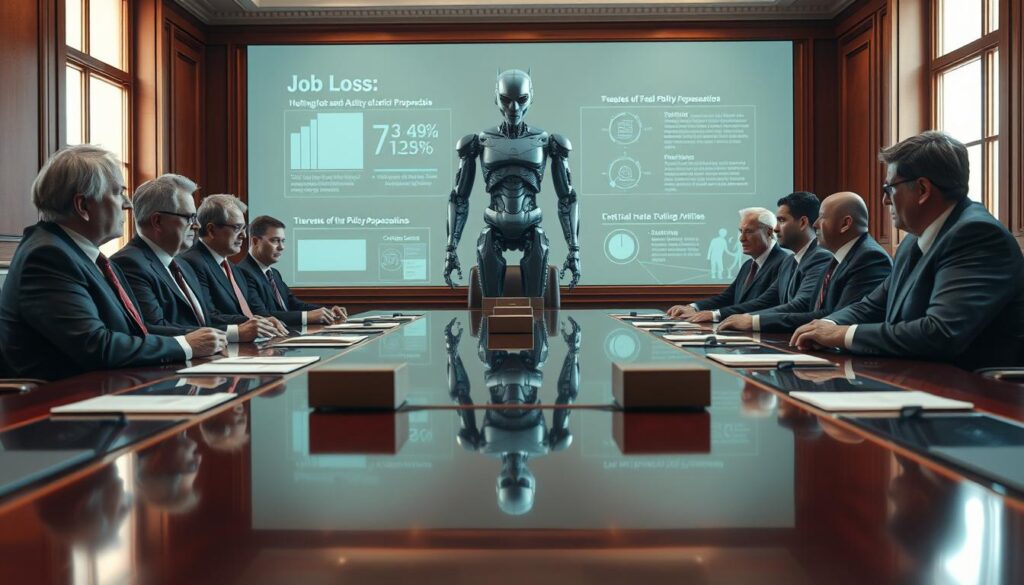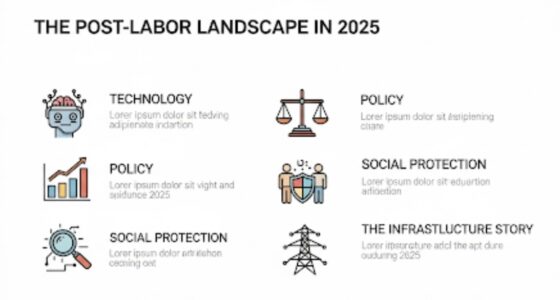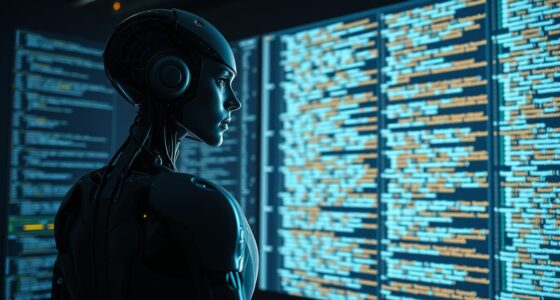Did you know that by 2030, automation could displace up to 375 million workers globally, according to a recent McKinsey report? This staggering statistic underlines the urgency of understanding how artificial intelligence (AI) is reshaping the job market, particularly for white-collar jobs. As AI continues to advance at an unprecedented pace, you may find yourself facing significant job displacement challenges. This article aims to guide you through the evolving employment landscape, predict potential job losses, and offer effective employment strategies to help you adapt and thrive in an AI-dominant future.
Key Takeaways
- AI has the potential to significantly impact white-collar jobs.
- Anticipating job displacement is crucial for effective workforce adaptation.
- Understanding the future job landscape can help in planning your career path.
- Proactive employment strategies are essential to stay relevant in an AI-driven world.
- Staying informed about AI trends will equip you to face upcoming changes.
The Rise of AI and Its Impact on Employment
AI advancements are transforming the landscape of work, with a growing influence on various sectors. As these technologies evolve, they reshape employment trends, creating a paradigm shift in how tasks are executed. Companies are increasingly relying on AI to automate routine jobs, leading to significant workforce disruption.
Research indicates that industries focused on predictable and repetitive tasks are most vulnerable. In sectors such as manufacturing, customer service, and data entry, many positions could become obsolete as AI takes center stage. The implications of this shift are profound, sparking debates among experts regarding the future of work.
Recognizing the potential for widespread layoffs, organizations, and policymakers are urged to prepare for the changing job market. Adapting to AI’s integration into daily operations requires strategic planning and workforce development initiatives. Failing to address these challenges may exacerbate employment disparities, resulting in a broader impact on societal stability.
To gain a clearer understanding of AI’s effects, examining current data and predicting future trends becomes essential. Awareness of these shifts can empower you to make informed career choices and navigate the evolving job market effectively.
| Industry | Vulnerability to AI | Potential Job Disruption (%) |
|---|---|---|
| Manufacturing | High | 60 |
| Customer Service | Medium | 45 |
| Data Entry | High | 70 |
| Healthcare Administration | Low | 20 |

Understanding the Job Landscape in 2025
The landscape of employment is evolving rapidly as advances in artificial intelligence reshape various industries. Understanding these changes is crucial for anyone navigating the job market. Job prediction models indicate significant shifts in employment patterns by 2025, largely attributed to the automation impact on multiple sectors. The potential for job losses by 2025 ranges dramatically, with estimates suggesting as high as 50% of entry-level office jobs could be at risk.
AI Predictions for Job Losses
Experts warn that the increase in automation will contribute to heightened unemployment rates, ranging from 10% to 20% in specific sectors. As AI technologies continue to improve and become more cost-effective, many roles previously thought secure may face elimination far sooner than anticipated. You must start thinking about career stability in light of these forecasts.
Industries Most Affected by AI
Particular industries are more vulnerable to disruption from AI, leading to extensive job losses by 2025. For instance, the banking sector is undergoing a major transformation as large banks close branches and pivot towards digital services. Insurance and administrative support fields are similarly at risk due to the ongoing push for efficiency through automation. These shifts highlight critical areas where you might consider future job opportunities or reskilling efforts.

AI Taking Over – A White Collar Job Bloodbath
The rise of artificial intelligence has significantly altered the employment landscape, particularly in the realm of white collar jobs. Those who perform tasks defined by predictability and routine face the greatest risk as automation becomes more prevalent. Understanding how the AI impact on employment manifests in your field may help you prepare for the forthcoming changes.
Who Will Be Most Affected?
Workers engaged in administrative roles, bureaucratic positions, and office support functions will likely experience the most significant disruptions. As organizations increasingly rely on AI technologies, the need for human intervention in these jobs diminishes. Identifying these roles can help you recognize potential threats to job security and plan for new career paths.
| Job Type | Risk Level | Examples of Tasks |
|---|---|---|
| Bureaucratic roles | High | Data entry, report generation |
| Office support | Medium | Scheduling, correspondence management |
| Administrative assistants | High | Document preparation, clerical tasks |
| Customer service representatives | Medium | Basic inquiries, complaint processing |
Being aware of these trends empowers you to anticipate the shifts and navigate the evolving job market effectively. Emphasizing adaptability and fostering new skills will be paramount to thrive in a landscape increasingly dominated by AI.

The Vulnerable Workforce: Bureaucrats and Administrative Roles
The landscape of bureaucratic jobs and administrative work faces immense challenges as job automation becomes increasingly prevalent. Many positions within this sector are susceptible to rapid changes brought on by advancements in artificial intelligence. Understanding which roles will be the most affected enables organizations and individuals to strategize effectively for the future.
What Positions Are at Risk?
Many administrative roles involve routine tasks easily managed through automation. Positions such as data entry clerks and customer service representatives are particularly vulnerable. These jobs typically require limited decision-making, making them prime targets for replacement by AI systems. The growing trend toward *job automation* signifies a need for a proactive approach in identifying the positions at risk, allowing for focused retraining efforts.
The Future of Bureaucratic Jobs
The future of bureaucratic jobs lies in evolving from traditional roles to new ones that integrate AI. As automated systems handle mundane tasks, the demand for specialists who can collaborate with these technologies will increase. This shift indicates that while some roles may diminish in number, new opportunities will emerge, necessitating a rethinking of job changes in administration. Embracing this transformation positions you to thrive in an evolving workforce environment.

Women and the Job Market: Challenges Ahead
The landscape of employment is undergoing significant changes, especially for women in the workforce. As AI technologies continue to evolve, the potential consequences for job equality come into sharp focus. Women occupy a considerable number of roles in sectors vulnerable to automation, which raises urgent questions about the future of job security for this demographic.
The Impact of AI on Women’s Employment
Women disproportionately fill positions in administrative roles, customer service, and other sectors that AI can easily automate. The AI impact on women is profound, as these jobs often serve as entry points into the workforce, making job loss particularly detrimental. Addressing these disparities is crucial for promoting job equality and ensuring that women maintain their footing in professional settings.

According to recent research, over 30% of women employed in vulnerable job roles may face job displacement within the next few years. This alarming trend highlights the urgent need for interventions that support women in navigating this evolving job market. Organizations and policymakers must develop strategies that not only aim at reskilling but also focus on ensuring that women have equitable access to emerging opportunities in new sectors.
| Sector | Percentage of Women Employed | Risk of Job Displacement |
|---|---|---|
| Administrative Support | 70% | High |
| Customer Service | 60% | Medium |
| Retail Sales | 50% | Medium |
| Healthcare Support | 40% | Low |
This table illustrates the sectors in which women are heavily represented and their corresponding risks of job displacement. As automation continues to reshape these industries, the imperative to secure job equality for women becomes increasingly critical, enabling them to thrive amidst change.
Young Professionals: Facing an Uncertain Future
Young professionals are navigating a job market fraught with challenges stemming from rapid technological advancements. Job uncertainty looms large as automation increasingly takes over roles once deemed essential. Entry-level positions, the traditional stepping stones for many, are dwindling in number.
In an effort to thrive in this evolving landscape, it becomes crucial for you to develop advanced skills in AI literacy. As the nature of work transforms, education systems must also pivot, ensuring young professionals are equipped with the necessary tools to adapt. It is vital to focus on acquiring skills that enhance your employability in an era defined by digital innovation.
Employers are seeking candidates who not only meet basic qualifications but demonstrate a proactive approach to personal and professional growth. The ability to adapt to new tools and technologies will set you apart in your quest for meaningful employment amidst uncertainty.

Strategies to Adapt to AI Disruption
As artificial intelligence continues to reshape the job landscape, you must prioritize strategies that facilitate adaptation. Embracing reskilling and lifelong learning proves essential for staying competitive. Both individuals and employers need to commit to ongoing education tailored to the evolving demands of the workforce.
Importance of Reskilling and Lifelong Learning
Reskilling allows you to acquire new skills necessary for roles that integrate AI technologies. Engaging in lifelong learning helps you stay ahead of industry trends, ensuring you remain relevant in the job market. Companies can support these efforts by offering training programs that empower their workforce in navigating transitions effectively.
Exploring New Career Paths
The changing landscape presents opportunities to explore unconventional career paths. Consider roles that combine human skills with AI capabilities. Careers requiring creativity, empathy, and complex problem-solving will maintain their value. Investing in personal development will enhance your adaptability and strengthen your position in the workforce.

The Role of Governments in Mitigating Job Losses
As AI technologies continue to evolve and reshape various industries, a robust government response to AI has become crucial. By implementing effective national adaptation strategies, governments can help mitigate the job losses associated with the rise of artificial intelligence. This proactive approach requires a comprehensive understanding of the job landscape and the potential impacts of AI on employment.
Proposed National AI Adaptation Strategies
To address the challenges posed by AI, here are some proposed strategies that can be implemented:
- Coordinated retraining programs to equip workers with skills relevant to the AI-driven job market.
- Financial support for individuals who face displacement due to automation.
- Investment in education systems to promote STEM (science, technology, engineering, and mathematics) and digital literacy among students.
- Policies encouraging innovation while ensuring workforce protection and development.
- Partnerships with businesses to create apprenticeship and mentorship opportunities in emerging fields.

Business Investments in Workforce Development
In an increasingly AI-driven job market, the significance of business investment in workforce development cannot be overstated. Companies must recognize that enhancing employees’ skills through effective training programs is vital for maintaining competitiveness. This approach not only prepares your workforce for evolving job demands but also serves to harness human oversight in an environment where machines take on more responsibilities.
The Need for Training Programs
Robust training programs are essential for equipping employees with the tools they need to adapt to new technologies and workplace dynamics. By implementing initiatives that focus on critical thinking, creativity, and advanced problem-solving, businesses can cultivate a workforce capable of thriving alongside AI systems. Investing time and resources into these areas promotes an agile atmosphere, fostering innovation and responsiveness to change.
Companies Leading the Change
Several innovative companies are setting the precedent in this realm by prioritizing workforce development and showcasing their commitment through ongoing training programs. These organizations understand that their success hinges on continuously developing their teams. By spearheading initiatives that promote a culture of learning, businesses can enhance productivity while significantly boosting employee satisfaction and loyalty.

Exploring New Opportunities with AI
As AI technology evolves, it is reshaping the workforce landscape, leading to the emergence of new job functions that blend technology with creativity. These changes bring a surge of emerging job roles that capitalize on innovative thinking and human insight. For example, positions like AI ethics consultants and data interpreters are increasingly vital, highlighting the need for human-centric skills amidst automation.
Creative Job Roles Emerging from AI
The integration of AI into various sectors opens the door to a variety of creative career opportunities. These roles not only demand technical knowledge but also require imaginative approaches to leverage AI effectively. From content creators who use AI tools to enhance storytelling to strategists who develop campaigns based on AI-generated data, the workforce is seeing a shift toward positions that prioritize creativity combined with analytical skills.
The Importance of Human Skills in an AI World
While AI can automate many processes, the importance of human skills becomes more pronounced. Emotional intelligence, critical thinking, and problem-solving abilities will be essential in distinguishing yourself in an evolving job market. As jobs transform, your capacity to combine these skills with a deep understanding of AI technology will define your role within the future workforce. By valuing these human traits, you can ensure your adaptability and relevance as the job landscape continues to change.

Preparing for a Future with AI
Embracing the changing dynamics of the AI landscape will crucially determine your success in the evolving job market. Future preparation necessitates a proactive approach to skill acquisition and adaptability. Understanding various AI applications and their impact across industries is essential for maintaining competitiveness.
Your journey towards workforce readiness should involve continuous learning and a willingness to embrace technological advancements. Familiarity with emerging tools, platforms, and AI-driven methodologies can greatly enhance your employability. Keep abreast of trends in automation and AI developments that are reshaping job roles and responsibilities.
Engaging with peers in discussions about the AI landscape can provide insights into necessary competencies and emerging opportunities. Building a network with professionals already thriving in AI-enhanced environments can lead to mentorship or collaboration prospects. Commit to ongoing personal and professional growth to secure a stable position in this rapidly changing market.

Coping with Job Loss and Transition
Navigating job loss in an age increasingly dominated by AI presents significant challenges. Emotional distress can accompany the end of employment, making it crucial to find effective coping strategies. Seeking emotional support often involves connecting with professionals who offer counseling or joining support groups where shared experiences can foster resilience. Financial resources are equally important; budgeting, financial counseling, and exploring unemployment benefits can help ease the transition.
Emotional and Financial Support Resources
Accessing resources for emotional and financial support can greatly alleviate stress during this transitional period. Integrated approaches combine both elements, encouraging individuals to embrace community resources, workshops, and other support systems. Many organizations provide tailored programs that can guide individuals through the maze of emotions and financial uncertainty.
Community Approaches to Workforce Adaptation
Communities play a vital role in facilitating workforce adaptation, offering initiatives that strengthen skills and employability. Local training programs and workshops create opportunities for personal growth and networking. Sharing resources within communities fosters collective resilience, ensuring that individuals are not alone in their journey. By building robust community networks, individuals can navigate job transitions more effectively and find pathways that lead to stability and new opportunities.

Conclusion
The rapid rise of AI in the workforce brings both challenges and opportunities that shape our workplace future. As you navigate through the uncertainties posed by AI job disruption, it becomes increasingly important to adopt a forward-thinking mindset. Emphasizing career survival through proactive reskilling and development will empower you to not only adapt but thrive in an environment that is quickly evolving.
Individuals and organizations alike must recognize the significance of collaboration in this endeavor. By working together, governments, businesses, and communities can ensure a more balanced approach to the integration of technology in our workplaces. When the right strategies are deployed, rather than facing displacement, society can embrace a landscape where technology enhances human potential and fosters meaningful employment.
Ultimately, the key to successfully navigating this transformative era lies in your ability to remain agile and open to new learning opportunities. Embracing change, fostering resilience, and investing in skills that complement AI will pave the way for a sustainable future. Your journey towards career survival in this new paradigm isn’t just a matter of adaptation; it is an invitation to redefine what success means in an AI-driven world.









